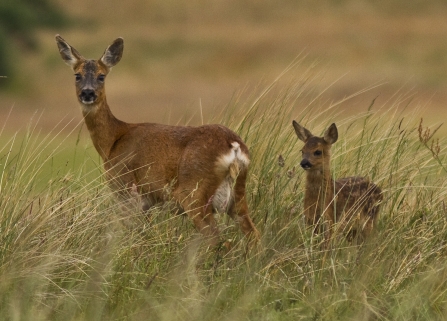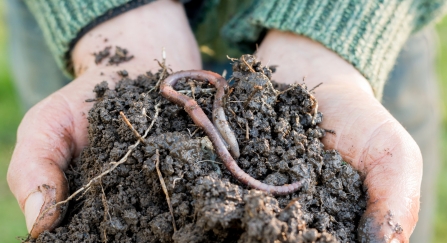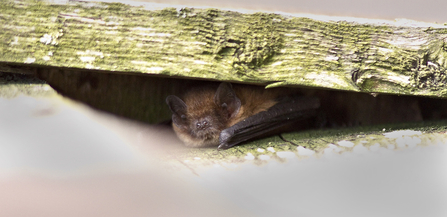Blood-thirsty bats and murderous mating rituals - is wildlife really as spooky as we make it out to be? Take the quiz to find out...
The spooky wildlife quiz
Q1: Rabbits eat their own poo!
True or false?
True.
Rabbits eat their own poo several times a day to digest as much goodness from their food as possible.

Jon Hawkins - Surrey Hills Photography
Rabbits are thought to have been introduced to the UK on a large scale by the Normans for food and fur during the 12th Century. Now, they are a common and beloved British sight, perched upright on strong hind legs or darting through the long grass.
Q2: Deer are herbivores
True or false?
False.
Some types of deer have been known to eat all sorts of things, including frogs and old bones.

Harry Hogg
Six species of wild deer live in the UK. Of those, only two (the red deer and roe deer) are truly native. It is widely thought that, as with rabbits, it was the Normans who first introduced fallow deer to Britain, whilst the muntjac, Chinese water deer and sika deer arrived later, during the late 19th and early 20th centuries.
Q3: Spiders eat their husbands
True or false?
True (some of the time).
Not all female spiders do this, but some do it every time! It depends on her personality.

House spider by Dr Malcolm Storey
The UK is home to a mind-boggling 650 different species of spider and autumn is a great time to see them as they reach full maturity and are drawn to the warmth of our homes. Spiders are sadly feared but rest-assured, in the UK, spider bites are very rare and none cause any long-term harm.
Q4: When worms are chopped in half, they become two worms
True or false?
False.
The head of a worm can grow a new tail, but the tail cannot grow a new head to become a new worm.

There are lots of great alternatives to peat-based compost
Worms are underground engineers, their networks of tunnels and burrows helping to aerate the soil and improve drainage. Worms also recycle important nutrients back into the soil, helping the entire ecosystem to thrive. The largest earthworm in the UK is known as the nightcrawler and can grow to more than 30cm long.
Q5: One British bird catches its prey and hangs it on thorns to create a larder
True or false?
True.
The shrike is also known as the butcher bird and eats insects, frogs and small mammals. Unfortunately, shrikes are much harder to see than they used to be.

red-backed shrike by Stefan Johansson
In the autumn a small number of great grey shrikes will come to the UK to spend the winter here. They are highly territorial and often get mobbed by other birds which recognise them as dangerous predators. Sadly, the red-backed shrike has suffered a dramatic decline and is virtually extinct as a UK breeding species. Help us address nature's decline and put nature back into recovery by joining our 30 by 30 campaign.
Q6: Bats drink blood!
True or false?
False, at least in Britain.
Vampire bats, which bite their prey to draw blood before lapping it up, are only found in Central America.

(c) Harry Hog
In the UK, bats live purely off a diet of insects, and it certainly takes a lot of insects to fill their appetite. The pipistrelle bat will eat 3.5 thousand insects – the equivalent of 60 roast dinners – in one sitting.
Q7: Earwigs live in our ears!
True or false?
False.
Earwigs only feed on plants, not human brains, and they never enter our ears.

Earwig by Chris Lawrence
The common earwig is a nocturnal creature, only venturing out from its hiding place to feed by night. Their diet consists of dead and decaying matter, helping to recycle nutrients back into the soil.
Earwigs are caring mothers, guarding their nests and gently cleaning their eggs until they hatch.
Q8: Ladybirds are cannibals (they eat each other)
True or false?
True.
Ladybirds eat their own eggs to reduce competition amongst their offspring. Ladybird larvae will also eat the unhatched eggs of their siblings.

There are 26 types of ladybird in the UK. Rather than the number of spots indicating how old a ladybird is, the spots can actually be used to help you identify which species you are looking at.
Q9: You are more likely to be killed by a shark than a cow
True or false?
False.
Across the globe, more people die from cow kicks each year than shark bites.

JP Trenque
The UK is home to more than 40 species of shark including the second largest species of shark in the world, the basking shark. Basking sharks are gentle giants, living off a diet of plankton which they hoover up with their enormous mouths.

